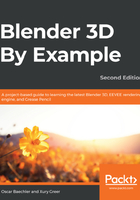
Creating previz objects
Now that we have a floor plan, we need to make some previz models to represent where our finished kitchen assets will go.
We want the models in our scene to match the dimensions of the real world. We don't have to get bogged down with the details, but as often as possible, we need to model our scene with accurate measurements. You can even go around your house with a tape measure to get measurements. Meters are the default unit in Blender, so we'll measure in m. Here are some approximate measurements for objects in the real world
When we previz these objects in our scene, we don't need to model in any of the details. Instead, we can simply create cubes that have the correct proportions for the objects they represent. Let's create a previz table according to the preceding measurements:
- Add a cube.
- Rename the cube to table_p (p stands for previz).
- Move the cube 1 m upward so that it resets on the grid.
- Open the sidebar by pressing the n hotkey.
- Switch to the Item tab in the sidebar if it's not already active.
As we know, an object's transforms give us information about where that object is in the scene. The Item tab in the sidebar gives us a quick display of this information. If we look at the location data, we'll notice a problem with our new cube—it reads 0 m, 0 m, 1 m. This is because we moved the cube up 1 m in Object Mode. The orange dot in the center of the object, which represents the object's origin, also floats 1 m above the grid. When a model is centered in the scene, these numbers should read 0 m, 0 m, 0 m—that way, Blender knows that the object is in its resting position. When we move the object away from the center, these numbers will accurately represent how far away the object is from its resting position in each direction. But right now, Blender thinks that the object is not in its resting position; it thinks it's floating 1 m above the ground. Let's fix this by applying the location while the cube is centered above the grid:
- Press the Ctrl + A hotkeys to open the Apply menu.
- Choose Location from the menu.
Good, now we have a cube with an origin point that rests on the center of the grid. The cube's origin has returned to the center of the grid while leaving the cube's geometry sitting on top of the grid. As we can see in the sidebar, Location reads 0 m, 0 m, 0 m. In the later stages of this project, each object will be placed in a specific location in the scene and the Location numbers will perfectly correspond to its alignment in the scene.
Lastly, we can use the sidebar to set the dimensions of the cube to match the table from our previous measurements:
- Find the Dimensions numbers at the bottom of the sidebar.
- Type 1 m in X for the width.
- Type 2.5 m in Y for the depth.
- Type 0.8 m in Z for the height.
Now, it's the correct size, but setting the dimensions has distorted the scale of our object. Right now, it reads 0.5, 1.25, 0.4, which is all sorts of wrong. All finished models should read 1, 1, 1 for scale, so we need to apply scale to fix it:
- Press the Ctrl + A hotkeys to open the Apply menu.
- Choose Scale from the menu.
It may just be an elongated cube, but it's a good enough representation of our table that we can use it to previsualize the layout and composition of our kitchen. Let's enable a Viewport Display option that will help us remember what this object is supposed to be:
- Select the table_p object.
- Open the Object Properties tab in the Properties panel.
- Open the Viewport Display subsection.
- Check the box for Name.
Good, now we can see the name of the object in the viewport. Make additional previz cubes for each of the objects that you want to use in your kitchen scene. Use the preceding chart for size references or get out a tape measure and gather some references of your own. Next, we'll use these previz objects to test out the composition of the final scene.